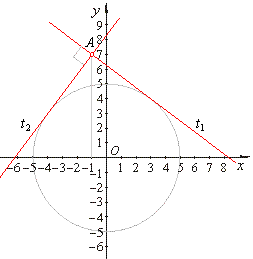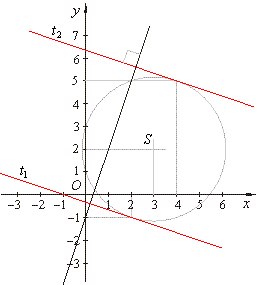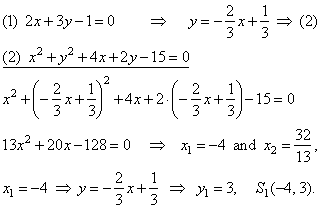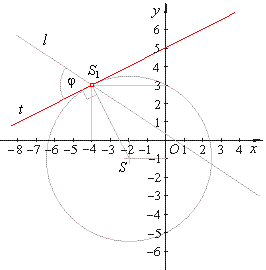|
|
|
|
Circle
and Line
|
 Condition of tangency - Condition for a line to be the tangent to a circle
Condition of tangency - Condition for a line to be the tangent to a circle
|
|
Condition for a line to be the tangent to the circle with
the center at the
origin
O(0, 0)
|
|
Condition for a line to be the tangent to the translated circle
|
 Tangents to a circle from a point outside the circle - use of the
tangency condition
Tangents to a circle from a point outside the circle - use of the
tangency condition
|
 Angle between a line and a
circle
Angle between a line and a
circle
|
|
|
|
|
|
|
| Condition of tangency - Condition for a line to be the tangent to a circle
|
| Condition for a line to be the tangent to the circle with center at the
origin
O(0, 0)
|
A line touches a circle if the distance of the center of the circle to the line is equal to the radius of the circle,
i.e., if d
= r. |
| The distance of the center
S(0,
0) of a circle
x2
+ y2 = r2
from a line y =
mx + c
or -mx
+ y -
c
= 0, |
 |
| and after squaring
obtained is |
r2·(m2
+ 1)
= c2 |
the condition for a line
y =
mx + c
to be a tangent |
|
| to the circle
x2
+ y2
= r2. |
|
| Condition for a line to be the tangent to the translated circle (x
-
p)2 + (y -
q)2 = r2 |
| In this case, the distance
d
of the center
S(p,
q) of the circle to a line
-mx
+ y -
c
= 0 (
or
y =
mx + c ),
must be equal to the radius r
of the circle, thus |
 |
| after squaring
obtained is |
r2·(m2
+ 1)
= (q -m
p -
c)2 |
|
|
| the condition for a line
y =
mx + c
to be a tangent
to a translated circle with the center at S(p,
q). |
|
| We can derive the same conditions using
the tangency criteria which implies that the discriminant of the
system of equations of a line and a circle, in that case, must be zero. |
| Then will the system have only one solution, i.e., the line and the circle will have only one common point,
the tangency point. |
| 1)
The condition for a line y =
mx + c
to be tangent to the circle x2
+ y2
= r2, |
|
(1) y =
mx + c
plugging (1)
into (2)
gives the quadratic equation, |
|
(2) x2
+ y2 = r2
(m2
+ 1) · x2
+ 2mc · x
+ c2
-
r2
= 0 and
according to the condition, |
| |
| D
= b2
-
4ac = 0 or
(mc)2
- 4(m2
+ 1)(c2
- r2)
= 0 gives
r2·(m2
+ 1)
= c2
the tangency condition. |
|
| 2)
The condition for a line y =
mx + c
to be tangent to the circle (x
-
p)2 + (y -
q)2 = r2, |
|
(1) y =
mx + c |
|
(2) (x
-
p)2 + (y -
q)2 = r2 |
| |
| by
plugging (1)
into (2)
obtained is (m2
+ 1) · x2
+ 2(mc - mq
- p)
· x
+ p2
+ c2
+ q2 -
r2
-
2cq = 0 |
| then,
from the condition D
= b2
-
4ac = 0
follows
r2·(m2
+ 1)
= (q -m
p -
c)2
the
tangency condition. |
|
| Tangents to a circle from a point outside the circle - use of the
tangency condition
|
| Example:
Find the angle between tangents drawn from the point
A(-1,
7) to the circle
x2
+ y2 = 25 . |
| Solution:
Equations of tangents we
find from the system formed by equation of the line and the
tangency condition, |
|
A(-1,
7) => (1)
y =
mx + c => c =
m + 7
=> (2) |
|
(2) r2·(m2
+ 1)
= c2 |
|
|
|
25(m2
+ 1)
= (m + 7)2 |
| 12m2
-
7m
-
12 = 0 => m1
= -
3/4
and
m2
= 4/3 |
| c1
= -
3/4 + 7 = 25/4 and
c2
= 4/3 + 7 = 25/3 |
| therefore,
the equations of tangents, |
| t1
::
y =
-
(3/4)x + 25/4 and
t2
::
y =
(4/3)x + 25/3. |
| Slopes of tangents satisfy perpendicularity condition, that is
|
| m1
= -
1/m2
=>
j =
90°. |
|
 |
|
|
| Example:
Given is a line
-3x +
y + 1 = 0 and a circle
x2
+ y2 -
6x
- 4y
+ 3 = 0,
find equations of tangents to the circle which are perpendicular to the line. |
| Solution:
Slopes of tangents are determined by condition of
perpendicularity, therefore |
| y =
3x -
1,
m =
3
so that
mt =
-1/3 |
| x2
+ y2 -6x
-4 y
+ 3 = 0
=>
(x
-
3)2 + (y -
2)2 = 10 |
| thus,
S(3,
2)
and
r2
= 10. |
| To
find intersections c
we use the tangency condition, |
| r2·(m2
+ 1)
= (q -m
p -
c)2 |
| 10[(-1/3)2
+ 1]
= [2 -(-1/3)·3
-
c]2 or
(3
-
c)2
= 100/9 |
| (3
-
c)
= ± 10/3
so c1
= -1/3
and c2
= 19/3. |
| The equations of
tangents are, |
| t1
::
y =
-(1/3)x
-1/3 and t2
::
y =
-(1/3)x
+19/3. |
|
 |
|
|
| Example: Find equations of the common tangents to
circles x2
+ y2 =
13 and (x
+ 2)2 + (y +
10)2 =
117. |
| Solution:
Slopes and intersections of common tangents to the circles must satisfy tangency condition of both
circles. Therefore, values for slopes m
and intersections c
we calculate from the system of equations, |
 |
| The
equation -10
+ 2m -
c = +3c
does not satisfy given conditions. |
| The
equation -10
+ 2m -
c = -3c
or c = 5 -
m plugged into (1) |
 |
| Therefore,
the equations of the common tangents are, |
 |
|
| Angle between a line and a circle
|
| The angle between a line and a circle is the angle formed by the line and the tangent to the circle at the
intersection point of the circle and the given line. |
|
| Example:
Find the angle between a line
2x +
3y -
1 = 0 and a circle
x2
+ y2 +
4x
+ 2y - 15
= 0. |
| Solution:
Coordinates of
intersections of the line and the circle calculate by solving the system, |
 |
| Rewrite
the equation of the circle to standard form, |
| x2
+ y2 +
4x
+ 2y - 15
= 0
=>
(x
-
p)2 + (y -
q)2 = r2 |
| thus,
(x +
2)2 + (y + 1)2 = 20,
S(-2,
-1) and
r2
= 20. |
|
 |
|
| Equation of the tangent at the intersection
S1, |
| S1(-4,
3)
=>
(x1 -
p) ·
(x -
p) + (y1 -
q) ·
(y -
q) = r2
|
| (-4
+
2)
· (x +
2)
+ (3 + 1)
·
(y
+
1)
= 20
=>
t
::
-
x
+ 2y
-
10
= 0
or y =
1/2x + 5 |
| The angle between the line and the circle is the angle formed by the line and the tangent to the circle at the
intersection point, therefore
|
 |
|
|
|
|
|
|